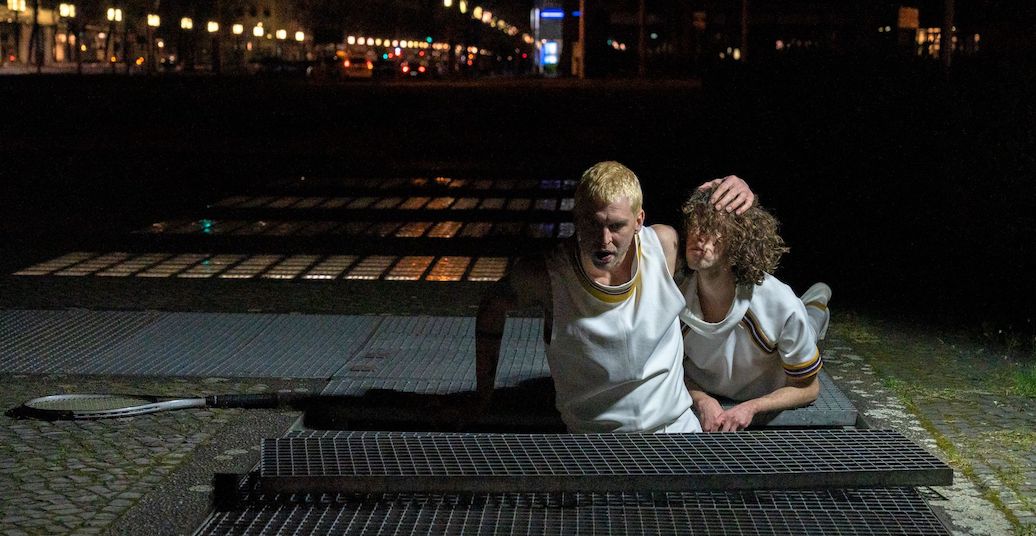On 21 and 22 April 2023, Johannes Wieland’s new work “we will be removed”, the second part of what will be a trilogy that began in 2016 with “you will be removed”, transformed the traffic island of Charlottenburg’s Ernst-Reuter-Platz into a large open-air stage.
It feels like the traffic island at Ernst-Reuter-Platz is fulfilling its unofficial purpose this evening. First planted at this east-west axis point after World War II and ordinarily only reachable from the subway station that lies underneath, it acts less as public space than as a backdrop to it. On the evening of the performance of “we will be removed” the place is even more reminiscent than usual of a big open-air theater: several oversized inflatable flamingo inner tubes float on the pools beneath the two fountains, a few empty white plastic chairs are scattered around, a few white sun umbrellas stick singly out of the grass, two tennis nets are stretched across the edges of the green area like barriers, and near the stairs that lead down to the subway is an obviously out-of-place car (scenic design: Momme Röhrbein). Before the guided tour of the island begins, it’s not totally clear what belongs to the everyday inventory of the area and what is a prop that was added later.
It is long past the planned start time, twilight spreads over Erst-Reuter-Platz like a blackout in slow motion. When the fountains are suddenly turned off, their echoing splashes are replaced by the swelling roar of ambient music, loud enough to drown out even the din of the cars swirling around the island (sound: Mattef Kuhlmey). Heavy city traffic becomes a muted background animation. Seemingly out of nowhere, a person completely dressed in white appears, hands full of tennis balls, and strides slowly through the loosely gathered audience (costume design: Stefanie Krimmel). As one ball after the other is tossed high in the air and repeatedly missed by an imaginary racket, the next scene is already underway: illuminated by the headlights of the car, which suddenly glows violet from within, a duet between two more dancers unfolds, their movements interrupted over and over by spasms that have the effect of glitches in an image. “we will be removed” continues to unfold following this schema: the six performers (Chris-Pascal Englund Braun, Meimouna Coffi, Jordan Gigout, Hendrik Hebben, Gotaute Kalmatavičiūtė, Fabian Riess), all dressed the same, keep appearing unannounced out of the darkness only to disappear again into it shortly after. The simultaneously occurring scenes sometimes take place illuminated amid the audience, sometimes on the dark periphery of the traffic circle, so that the spectators always have to reorient themselves and thus stay in constant motion.
In addition, “we will be removed” plays skillfully with other forms of media throughout: the clearly framed images full of snippets of dialogue and swirling limbs that can pop up anywhere, at any time, feel like excerpts from a graphic novel. Then again, the performance feels like a video game: everything seems to be scripted meticulously, the whole area crisscrossed by invisible thresholds, the crossing of which can unlock new areas, trigger actions, or create moods. And even more frequently you get the impression that you’re on a film set: there are loudspeakers everywhere, spotlights and other mounted technical equipment, and around many corners a surprising mini auditorium opens up. And because so many smartphone cameras are following the Instagrammable dancers, their spectacular poses and virtuosic movements that sometimes unexpectedly synchronize, it’s not completely clear whether the handheld spotlights that are used over and over are because of the digital recording or the analogue movement.
Near the end, a fire is briefly lit. Yet even then the prophecy implied by the title (that of our removal from the place where all this is happening) doesn’t come to pass. “we will be removed” is, contrary to what might be suggested by the interplay of title and performance in public space, not a commentary on the increasingly precarious conditions of public art. Rather, the piece is much more a study of the site’s theatrical possibilities. As the performers descend through grates into underground shafts, as the fountains are stopped and restarted, spotlights constantly turned on and off all over the place, the specific infrastructure of the traffic island is exposed during the performance. And so, through the final applause, the vague idea of a city under the direction of the theater emerges.
English translation by Cory Tamler
„we will be removed“ by Johannes Wieland was presented on 21 and 22 April 2023 in Berlin at Ernst-Reuter-Platz.




